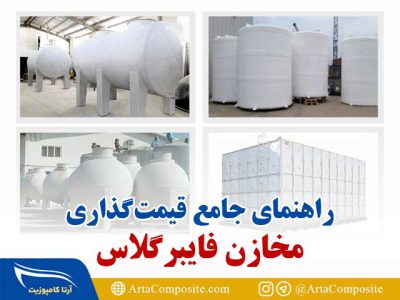Everything about the fiberglass industry

Everything about the fiberglass industry
A revolution in the chemical industry with fiberglass reinforced plastics (FRP)
Introduction: Chemical industry is one of the foundations of modern society, which provides essential materials and products for various applications from pharmaceuticals to other industries. However, The fiberglass industry faces unique challenges, including the need for rust-resistant equipment due to the highly corrosive nature of many chemicals. The introduction of fiberglass reinforced plastic (FRP) equipment is a revolutionary solution that is changing the chemical industry. In this article, we will explore the world of FRP, its features, benefits and methods that are reshaping the chemical industry.
Fiberglass industry
- Basic Concepts of Fiberglass Reinforced Plastic (FRP):
Fiberglass reinforced plastic, commonly known as FRP, is a material composed of a polymer matrix reinforced with Fibers are glass. This combination results in a material that has a unique set of properties for various industrial applications, including the chemical industry.
1.1 Composition of FRP:
FRP consists of two main components:
1.1.1 Polymer matrix: usually the polymer matrix from Thermostatic resins such as epoxy, polyester or vinyl ester are formed. These resins provide the mechanical structure and chemical resistance of FRP equipment.
1.1.2 Glass fibers: Glass fibers act as a reinforcement within the polymer matrix. These fibers give strength, hardness and stability to the composite material. The type and arrangement of glass fibers can be ordered to meet specific needs.
Fiberglass industry
2 Features of FRP
FRP equipment offers a wide range of features that make it a preferred choice in the chemical industry.
2.1 Rust resistance:
One of the most important advantages of FRP equipment in the chemical industry is its exceptional resistance to rust. Unlike traditional materials such as steel or concrete, FRP is highly resistant to corrosion when in contact with chemicals. This feature increases the useful life of the equipment and significantly reduces maintenance costs.
2.2 Lightness
FRP is lighter than materials such as steel. This feature simplifies the transportation and installation processes and makes it a lower cost option for various applications in the chemical industry.
2.3 High strength
Despite its lightness, FRP has considerable strength. This property prevents undesirable mechanical deformation, making it suitable for certain applications including storage tanks, piping systems, and pressure vessels.
2.4 dimensional stability
FRP equipment maintains its dimensional stability even in severe environmental conditions. This equipment prevents deviation and inflation and is the best performance for long periods of time.
2.5 Electrical insulation
FRP is an excellent electrical insulator that is common in chemical industries that have electrical equipment and tools, this feature prevents electrical hazards.
2.6 Thermal insulation
FRP also offers good thermal insulation properties, which are useful in applications where temperature control is essential, such as chemical reactors and heat exchangers.
Fiberglass industry
3 uses of FRP equipment in the chemical industry:
The chemical industry needs a variety of equipment to control and process different materials. FRP equipment is used in many fields of this industry:
3.1 Storage tanks
Storage tanks are critical components in the production and use of chemical industries. They are used to store raw materials, intermediate products and finished products. FRP storage tanks are an ideal choice due to their corrosion resistance, durability and ability to safely store a wide variety of chemicals.
3.2 Piping systems
Transporting chemicals within a manufacturing unit usually requires a complex network of piping. FRP piping systems are preferred due to their chemical corrosion resistance, lightweight design, and ease of installation.
3.3 Chemical reagents
Chemical reagents are very vital for the production of various chemical products. FRP reactors are used in processes where highly corrosive chemicals are used, as equipment resistant to harsh conditions and with long useful life.
3.4 washing machines and smoke hoods
Scrubbers and fume hoods are essential to control emissions and ensure worker safety in chemical plants. FRP is used to make these systems because of its resistance to corrosive gases and its ability to deal with a wide variety of chemicals.
3.5 Piping and ventilation systems
Proper ventilation in the chemical industry is very important to prevent the accumulation of toxic vapors and maintain a safe working environment. FRP piping and ventilation systems are used in the extraction of chemical vapors due to their corrosion resistance and the ability to withstand very harsh conditions.
3.6 Pressure tanks
Pressure vessels are used in various chemical processes that require the storage of gases or liquids at high pressure. FRP pressure vessels offer a safe and robust solution, especially in processes involving corrosive materials.
Fiberglass industry
4. advantages of FRP equipment in the chemical industry:
The use of FRP equipment in the chemical industry has increased significantly in recent years due to its many advantages:
4.1 cost effectiveness
FRP equipment offers a significant cost difference over traditional materials such as stainless steel or concrete. Reduced shipping costs, reduced installation time and minimal maintenance requirements lead to overall productivity.
4.2 Long life span
FRP equipment has a longer life and durability than many other materials. The corrosion resistance of this equipment ensures that it can withstand a long period of time and reduce the need for frequent replacements.
4.3 Chemical resistance
The exceptional chemical resistance of FRP equipment is a game changer in the chemical industry. This enables a wide range of corrosive chemicals to be safely handled without the risk of equipment erosion.
4.4 Reduction of maintenance
The low maintenance requirements of FRP equipment lead to reduced downtime and reduced maintenance costs. This is an important advantage in industries where equipment reliability is critical.
4.5 environmental impact
FRP is a sustainable and environmentally friendly material. Its long life reduces the need for frequent replacements and promotes waste minimization and reduced environmental impact.
4.6 Customization
FRP equipment can be customized to meet specific application needs. Flexibility in design allows for customized solutions that optimize performance and efficiency.
Fiberglass industry
5. Case studies: real applications of FRP equipment
To demonstrate the impact of FRP equipment in the chemical industry, let's take a look at some real case studies:
5.1 Case study 1: Chemical storage tanks
A chemical manufacturing plant was experiencing frequent problems and high maintenance costs in existing steel storage tanks due to chemical corrosion. They decided to replace steel tanks with FRP tanks. FRP tanks provide corrosion resistance and durability, reduce maintenance costs by 30% and extend service life by 15 years.
5.2 Case study 2: Acid storage factory
An acid handling plant was looking for a reliable solution for its chemical reactors dedicated to highly corrosive acids. They changed their tanks to FRP, which showed excellent corrosion resistance, leading to cost reduction and increased production efficiency.
5.3 Case study 3: Petrochemical facilities
A petrochemical facility needed to comply with strict environmental regulations to upgrade the gas extraction system. They switched to FRP ducting and hood ventilation systems, which not only improved emissions control but also reduced maintenance costs by 40% compared to their previous system.
Fiberglass industry
6. Challenges and Considerations
Although FRP equipment offers many advantages, there are also challenges and considerations to consider:
6.1 Initial cost
Although FRP equipment is more cost-effective in terms of useful life, the initial initial cost may be higher than some traditional materials. However, the savings in the long run usually make up for the value of this initial investment.
6.2 Installation expertise
Proper installation of FRP equipment requires expertise and special techniques. It is essential to work with experienced professionals to ensure the optimal performance of the equipment.
6.3 Material selection
Choosing the right type of FRP and resin matrix is very important. The choice should be made based on the specific chemicals and environmental conditions of the equipment.
6.4 Resistance to ultraviolet radiation
FRP equipment may not be suitable for outdoor applications without a UV-resistant coating or protection, as prolonged exposure to the sun can lead to degradation of the material.
Fiberglass industry
7. The future of FRP in the chemical industry
As the chemical industry continues to evolve, the role of FRP equipment is expected to expand further. Several trends and developments point to a promising future for FRP:
7.1 Progress in materials
Research and development efforts to improve the properties of FRP materials are ongoing. These measures include increased corrosion resistance, fire resistance, and UV resistance, opening up new possibilities for applications.
7.2 Stability
Sustainability is a common concern in all industries, especially the chemical industry. FRP's long life and recyclability make it a sustainable choice that is consistent with environmental goals.
7.3 Digitization and automation
The integration of digital technologies and automation in the chemical industry is likely to increase the demand for FRP equipment, especially to meet specific process needs.
7.4 Global expansion
As the chemical industry expands globally, demand for FRP equipment is expected to increase in emerging markets that require corrosion-resistant materials.
Fiberglass industry
۸. Conclusion
Fiberglass Reinforced Plastics (FRP) equipment has greatly changed the chemical industry by providing a reliable, cost-effective and corrosion-resistant solution for a wide range of applications. Its features such as corrosion resistance, lightweight design and durability make it a desirable choice for storing, transporting and processing chemicals safely and efficiently.
As the chemical industry continues to grow and adapt to new challenges, FRP equipment is on the way to play a greater role. With continuous advances in materials, a focus on sustainability, and the integration of digital technologies, FRP is on a path that can well support the continued evolution of the chemical industry, and the use of fiberglass equipment can have a significant impact on the future success of this industry.



